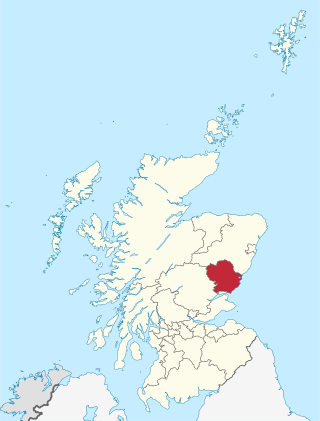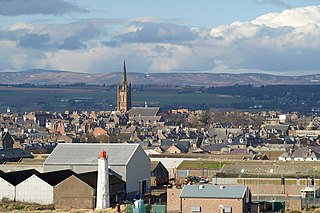
Angus is one of the 32 local government council areas of Scotland, a registration county and a lieutenancy area. The council area borders Aberdeenshire, Dundee City and Perth and Kinross. Main industries include agriculture and fishing. Global pharmaceuticals company GSK has a significant presence in Montrose in the east of the county.
Lallans, is a term that was traditionally used to refer to the Scots language as a whole. However, more recent interpretations assume it refers to the dialects of south and central Scotland, while Doric, a term once used to refer to Scots dialects in general, is now generally seen to refer to the Mid Northern Scots dialects spoken in the north-east of Scotland.
The National Party of Scotland (NPS) was a centre-left political party in Scotland which was one of the predecessors of the current Scottish National Party (SNP). The NPS was the first Scottish nationalist political party, and the first which campaigned for Scottish self-determination.

Montrose is a town and former royal burgh in Angus, Scotland. Situated 28 miles north of Dundee and 37 miles south of Aberdeen, Montrose lies between the mouths of the North and South Esk rivers. It is the northernmost coastal town in Angus and developed as a natural harbour that traded in skins, hides, and cured salmon in medieval times.

Christopher Murray Grieve, best known by his pen name Hugh MacDiarmid, was a Scottish poet, journalist, essayist and political figure. He is considered one of the principal forces behind the Scottish Renaissance and has had a lasting impact on Scottish culture and politics. He was a founding member of the National Party of Scotland in 1928 but left in 1933 due to his Marxist–Leninist views. He joined the Communist Party of Great Britain the following year only to be expelled in 1938 for his nationalist sympathies. He would subsequently stand as a parliamentary candidate for both the Scottish National Party (1945) and Communist Party of Great Britain (1964).

Earl of Airlie is a title of the peerage in Scotland created on 2 April 1639 for James Ogilvy, 7th Lord Ogilvy of Airlie, along with the title "Lord Ogilvy of Alith and Lintrathen". The title "Lord Ogilvy of Airlie" was created on 28 April 1491.

Lewis Grassic Gibbon was the pseudonym of James Leslie Mitchell, a Scottish writer. He was best known for A Scots Quair, a trilogy set in the north-east of Scotland in the early 20th century, of which all three parts have been serialised on BBC television.
The Scottish Renaissance was a mainly literary movement of the early to mid-20th century that can be seen as the Scottish version of modernism. It is sometimes referred to as the Scottish literary renaissance, although its influence went beyond literature into music, visual arts, and politics. The writers and artists of the Scottish Renaissance displayed a profound interest in both modern philosophy and technology, as well as incorporating folk influences, and a strong concern for the fate of Scotland's declining languages.

Violet Jacob was a Scottish writer known especially for her historical novel Flemington and for her poetry, mainly in Scots. She was described by a fellow Scottish poet Hugh MacDiarmid as "the most considerable of contemporary vernacular poets".
The Golden Treasury of Scottish Poetry was edited by Hugh MacDiarmid, and published in 1940. From the introduction:

Clan Donald, also known as Clan MacDonald, is a Highland Scottish clan and one of the largest Scottish clans. The Lord Lyon King of Arms, the Scottish official with responsibility for regulating heraldry in that country, issuing new grants of coats of arms, and serving as the judge of the Court of the Lord Lyon, recognises under Scottish law the High Chief of Clan Donald. Historically the chiefs of the Clan Donald held the title of Lord of the Isles until 1493 and two of those chiefs also held the title of Earl of Ross until 1476. Queen Mary of Denmark is member of Clan Donald.

William Soutar was a Scottish poet and diarist who wrote in English and in Braid Scots. He is known best for his epigrams.

Inverbervie is a small town on the north-east coast of Scotland, south of Stonehaven.

Montrose Academy is a coeducational secondary school in Montrose Angus. The School now teaches people from ages 11–18.

Clan Ogilvy, also known as Clan Ogilvie, is a Highland Scottish clan. Originating from Angus, Scotland, the progenitor of the Clan received a barony from King William the Lion in 1163. In 1491, King James IV elevated Sir James Ogilvy as Lord Ogilvy of Airlie.

William Lamb RSA was a British sculptor and artist. He was a survivor of the "lost generation" who came of age in 1914, and was scarred, both mentally and physically, by the First World War.
Margery Greenshields Palmer McCulloch was a Scottish literary scholar, author and co-editor of the Scottish Literary Review.
Marion Emily Angus (1865–1946) was a Scottish poet who wrote in the Scots vernacular or Braid Scots, defined by some as a dialect of English and others as a closely related language. Her prose writings are mainly in standard English. She is seen as a forerunner of a Scottish Renaissance in inter-war poetry – her verse marks a departure from the Lallans tradition of Robert Burns towards that of Hugh MacDiarmid, Violet Jacob and others.
George Malcolm Thomson OBE (1899–1996) was a Scottish journalist and publicist for Scottish nationalism. He is now best known for the sectarian slant he adopted the 1930s, aimed at Irish-Scots, and as an activist working on behalf of the Scottish Party. His biographer George McKechnie wrote "His modern Scottish reputation is grounded almost exclusively on his obsessive campaigns against Irish Catholics."
Muriel Craigie, OBE (1889–1971) was a leading Scottish suffragist, honoured by two nations as a major volunteer organiser in both World Wars, and a 'noted educationist' during local authority education reforms.











